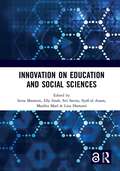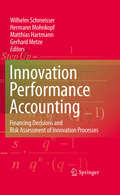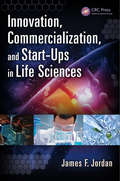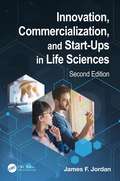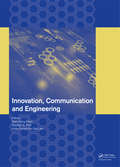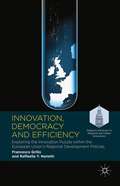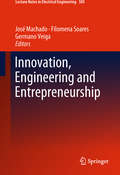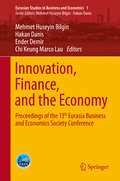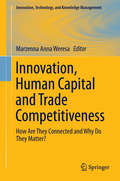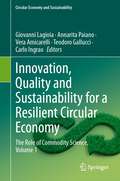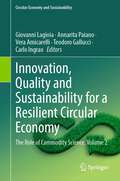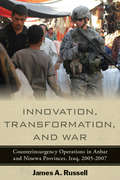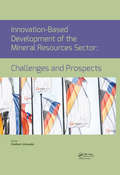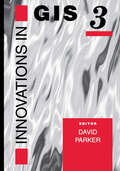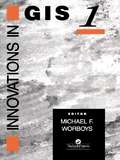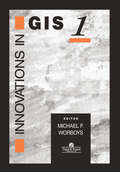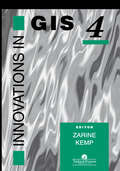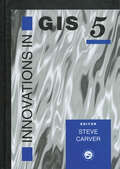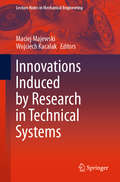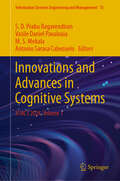- Table View
- List View
Innovation on Demand
by Victor Fey Eugene RivinThe revolutionary methodology for enhancing technological innovation called TRIZ is increasingly being adopted by leading corporations around the world to enhance their competitive position. This book explains how the TRIZ methodology harnesses creative principles extracted from thousands of successful patented inventions to help find more innovative solutions to design problems. Written for practicing engineers, product managers, technology managers and engineering students, it demonstrates how to use TRIZ tools for conceptual development of novel technologies, products and manufacturing processes.
Innovation on Education and Social Sciences: Proceedings of the International Joint Conference on Arts and Humanities (IJCAH 2021) October 2, 2021, Surabaya, Indonesia
by Irena MaureenAfter a year of a global Covid-19 pandemic, still, we have more questions than answers to the future of education and our social life. It is more important than ever to follow the developments closely in the coming period, pay attention to critical concerns such as inequality, as well as positive signs of transformation and innovation in all aspects of the world of teaching and learning. Expectations on what the future brings will have to be based on solid research rather than short-term perceptions. The proceedings of IJCAH 2021 are an interdisciplinary platform for teachers, researchers, practitioners, and academicians to discuss the latest research findings, concerns, and practical challenges encountered and solutions adopted in the fields of Arts and Humanities. The subject areas within the proceeding are education, language learning, arts, culture, social sciences.
Innovation performance accounting
by Matthias Hartmann Hermann Mohnkopf Gerhard Metze Wilhelm SchmeisserFor successful innovation in business the responsible managers need a consistent view of the individual processes as well as an assessment of key projects in all phases of the development. Generating new ideas, fast examination of its feasibility requires skilled methods for evaluation of these ideas, plans and especially costs and revenues. Business models, calculation methods and some assessments of certain options are presented by the authors. The ability to identify risks and appropriate responses to misperceptions are important milestones in the innovation process. From analysis of problems to the introduction of market-ready solutions, legal requirements, business demands and risk management systems are discussed. Concepts promoting uniform, binding rules for ratings in the innovation process are treated. The identification of target pricing, target costing and litigation, the evaluation of the solution to calculate risk aspects as tasks in financial management and innovation controlling are part of the content. The authors demonstrate that any innovation in different industries requires a strategic and financial project management. Monetary assessment of the individual processes, a detailed patent portfolio and accounts management for innovation processes are of enormous importance. The book is completed by applications of the Berlin Balanced Scorecard Concept with practical examples from the innovation projects in pharmaceutical and technical business.
Innovation, Commercialization, and Start-Ups in Life Sciences
by James F. JordanInnovation is the translation of a new method, idea, or product into reality and profit. It is a process of connected steps that accumulates into your brand or reputation. However, there can be many pitfalls and wrong turns on the road to realizing this goal. Innovation, Commercialization, and Start-Ups in Life Sciences details the methodologies ne
Innovation, Commercialization, and Start-Ups in Life Sciences
by James F. JordanInnovation is a translation of a new method, idea, or product into reality and profit. It is a process of connected steps that accumulates into a brand reputation required for success. Unlike Fortune 500 companies, whose projects are self-funded, a start-up must simultaneously have a value proposition that attracts a customer (for revenue), investors (for capital), and acquirers (for a liquidity event or IPO). A high percentage of start-ups fail before attaining positive cashflow, due to a variety of reasons that are detailed in this book.Avoiding the pitfalls and wrong turns are the goals of this book. Innovation, Commercialization, and Start-Ups in Life Sciences details the methodologies necessary to create a successful life science start-up from initiation to exit. Written by an expert who has worked with more nearly 500 life science start-ups, this book discusses specific processes and investor milestones that must be navigated to align customer, funder, and acquirer needs. Successful commercialization requires attention to multiple constituents, such as investors, regulators, and customers. Investors require liquidity for their return, which is achieved through selling their stock in a public or private sale. The reader will gain an appreciation for the necessary data, partnerships, and skills needed to create a competitive and sustainable company. The author discusses such specific issues as customer problems, demonstrating sales access, and ensuring intellectual property is impervious to competitive advancement. This book is intended to be suitable for entrepreneurs, venture capitalists, and investors in both business and academic settings. These organizations have specific departments, such as R&D, operations, business development, legal, regulatory, and marketing, that would also benefit from this book.FEATURES Focuses specifically on life science start-ups Examines how to determine a company valuation and future "fundable milestones" Explores how to align regulatory and clinical strategies Discusses intellectual property derived from a university or individual through formation to exit. Reviews how start‐ups must simultaneously meet the needs of multiple constituencies at once: investors, regulators, customers and exit candidates James F. Jordan is an author, consultant, and speaker. He is a Distinguished Service Professor of Healthcare & Biotechnology Management, a former Fortune 100 executive, and a managing director of a venture fund.Access the Support Material: https://healthcaredata.center/ Cover design by Sarah Mailhott.
Innovation, Communication and Engineering
by Stephen D. Prior Teen-Hang Meen Artde Donald Kin-Tak LamThis volume represents the proceedings of the 2013 International Conference on Innovation, Communication and Engineering (ICICE 2013). This conference was organized by the China University of Petroleum (Huadong/East China) and the Taiwanese Institute of Knowledge Innovation, and was held in Qingdao, Shandong, P.R. China, October 26 - November 1, 20
Innovation, Democracy and Efficiency: Exploring the Innovation Puzzle within the European Union's Regional Development Policies (Palgrave Advances In Regional And Urban Economics)
by Raffaella Y. Nanetti Francesco GrilloInnovation, Democracy and Efficiency.
Innovation, Dual Use, and Security: Managing the Risks of Emerging Biological and Chemical Technologies
by Jonathan B. Tucker Richard DanzigRecent advances in disciplines such as biotechnology, nanotechnology, and neuropharmacology entail a "dual-use dilemma" because they promise benefits for human health and welfare yet pose the risk of misuse for hostile purposes. The emerging field of synthetic genomics, for example, can produce custom DNA molecules for life-saving drugs but also makes possible the creation of deadly viral agents for biological warfare or terrorism. The challenge for policymakers is to prevent the misuse of these new technologies without forgoing their benefits . Innovation, Dual Use, and Security offers a systematic approach for managing the dual-use dilemma. The book presents a "decision framework" for assessing the security risks of emerging technologies and fashioning governance strategies to manage those risks. This framework is applied to fourteen contemporary case studies, including synthetic genomics, DNA shuffling and directed evolution, combinatorial chemistry, protein engineering, immunological modulation, and aerosol vaccines. The book also draws useful lessons from two historical cases: the development of the V-series nerve agents in Britain and the use and misuse of LSD by the U. S. Army and the CIA. Innovation, Dual Use, and Security offers a comprehensive, multifaceted introduction to the challenges of governing dual-use technologies in an era of rapid innovation. The book will be of interest to government officials and other practitioners as well as to students and scholars in security studies, science and technology studies, biology, and chemistry.
Innovation, Dual Use, and Security: Managing the Risks of Emerging Biological and Chemical Technologies (The\mit Press Ser.)
by edited by Jonathan B. TuckerA framework for assessing the security risks of emerging dual-use technologies and devising tailored governance strategies is proposed and applied to contemporary case studies.Recent advances in disciplines such as biotechnology, nanotechnology, and neuropharmacology entail a “dual-use dilemma” because they promise benefits for human health and welfare yet pose the risk of misuse for hostile purposes. The emerging field of synthetic genomics, for example, can produce custom DNA molecules for life-saving drugs but also makes possible the creation of deadly viral agents for biological warfare or terrorism. The challenge for policymakers is to prevent the misuse of these new technologies without forgoing their benefits. Innovation, Dual Use, and Security offers a systematic approach for managing the dual-use dilemma.The book presents a “decision framework” for assessing the security risks of emerging technologies and fashioning governance strategies to manage those risks. This framework is applied to fourteen contemporary case studies, including synthetic genomics, DNA shuffling and directed evolution, combinatorial chemistry, protein engineering, immunological modulation, and aerosol vaccines. The book also draws useful lessons from two historical cases: the development of the V-series nerve agents in Britain and the use and misuse of LSD by the U.S. Army and the CIA.Innovation, Dual Use, and Security offers a comprehensive, multifaceted introduction to the challenges of governing dual-use technologies in an era of rapid innovation. The book will be of interest to government officials and other practitioners as well as to students and scholars in security studies, science and technology studies, biology, and chemistry.
Innovation, Engineering and Entrepreneurship (Lecture Notes in Electrical Engineering #505)
by Filomena Soares José Machado Germano VeigaThis book presents endeavors to join synergies in order to create added value for society, using the latest scientific knowledge to boost technology transfer from academia to industry. It potentiates the foundations for the creation of knowledge- and entrepreneurial cooperation networks involving engineering, innovation, and entrepreneurship stakeholders. The Regional HELIX 2018 conference was organized at the University of Minho’s School of Engineering by the MEtRICs and Algoritmi Research Centers, and took place in Guimarães, Portugal, from June 27th to 29th, 2018. After a rigorous peer-review process, 160 were accepted for publication, covering a wide range of topics, including Control, Automation and Robotics; Mechatronics Design, Medical Devices and Wellbeing; Cyber-Physical Systems, IoT and Industry 4.0; Innovations in Industrial Context and Advanced Manufacturing; New Trends in Mechanical Systems Development; Advanced Materials and Innovative Applications; Waste to Energy and Sustainable Environment; Operational Research and Industrial Mathematics; Innovation and Collaborative Arrangements; Entrepreneurship and Internationalization; and Oriented Education for Innovation, Engineering and/or Entrepreneurship.
Innovation, Finance, and the Economy
by Mehmet Huseyin Bilgin Hakan Danis Ender Demir Chi Keung Marco LauThe first volume of the Eurasian Studies in Business and Economics, the official proceedings series of the Eurasia Business and Economics Society (EBES), includes selected papers from the 13th EBES Conference held in Istanbul in 2014. This volume covers theoretical and empirical contributions in the areas of innovation, entrepreneurship, HR, banking and finance. An eclectic set of methodologies and contributions from experts across the World makes this volume a valued work of reference. This volume also provides a timely opportunity to colleagues, professionals and students to catch up with the most recent studies in different fields and empirical findings on many countries and regions.
Innovation, Human Capital and Trade Competitiveness
by Marzenna Anna WeresaThis work focuses on researching and establishing the importance of human capital and innovation as determinants of competitive advantages in international trade--in the context of rapidly evolving technological advancement, globalization, and economic integration. The processes that accompany the shift from industrial economics to a knowledge-based economy are currently the object of interest of both scientists, politicians, investors and entrepreneurs. In many countries, the traditional sources of socioeconomic development, such as low labor costs, availability of inexpensive raw materials, and favorable geographic location are waning. These economies are searching for new sources of competitive advantage that will allow for maintaining growth, among other things by boosting participation in international trade. The book explores non-traditional drivers of competitiveness in both theory and practice. First, chapters 1 through 4 present theoretical and methodological aspects of the relationships among international trade, human capital and innovation. Here the authors address the controversy associated with the concept of competitiveness itself and its measurement, while paying special attention to the political development of comparative advantages related to international trade. The second part of the monograph, chapters 5 through 8, is of empirical nature. This section contains case studies of selected countries that represent models of various national innovation systems. Finally, the theoretical and practical aspects are integrated, allowing policymakers and financial and business leaders to consider how their decisions can influence their countries' competitive positions through their investments in innovation and human capital.
Innovation, Quality and Sustainability for a Resilient Circular Economy: The Role of Commodity Science, Volume 1 (Circular Economy and Sustainability)
by Carlo Ingrao Giovanni Lagioia Annarita Paiano Vera Amicarelli Teodoro GallucciThis book is a selection of the best papers presented at the XXX National Conference of Commodity Science held in Bari, Italy on 27 to 28th October, 2022. It is designed to help advance the knowledge and application of Commodity Science in innovation, quality, and sustainability principles and goals. Furthermore, it provides support in confronting the current environmental and socioeconomic challenges and contributes to addressing and solving those concerns in a circular economy context.Under this perspective, the book highlights the central role that Commodity Science can play, also considering the multiple possibilities of interacting with other relevant research sectors, like food production and packaging, engineering, environmental science, organisation, management, decision science, and social science, so enabling valorisation and rmaximisation. These interactions will appeal to academics, producers, decision- and policymakers, and other stakeholders.Thus, this book has a multidisciplinary holistically integrated approach to Commodity Science that contributes to enhancing the current literature and knowledge.
Innovation, Quality and Sustainability for a Resilient Circular Economy: The Role of Commodity Science, Volume 2 (Circular Economy and Sustainability)
by Carlo Ingrao Giovanni Lagioia Annarita Paiano Vera Amicarelli Teodoro GallucciThis book is the second volume of a selection of the best papers presented at the XXX National Conference of Commodity Science held in Bari, Italy on 27–28th October, 2022. It is designed to help advance the knowledge and application of Commodity Science in innovation, quality, and sustainability principles and goals. Furthermore, it provides support in confronting the current environmental and socioeconomic challenges and contributes to addressing and solving those concerns in a circular economy context. Under this perspective, the book highlights the central role that Commodity Science can play, also considering the multiple possibilities of interacting with other relevant research sectors, like food production and packaging, engineering, environmental science, organization, management, decision science, and social science, so enabling valorization and maximization. These interactions will appeal to academics, producers, decision- and policymakers, and other stakeholders. Thus, this book has a multidisciplinary holistically integrated approach to Commodity Science that contributes to enhancing the current literature and knowledge.
Innovation, Strategy and Risk in Construction: Turning Serendipity into Capability
by Martin LoosemoreInnovation, Strategy and Risk in Construction integrates insights from business and government leaders with contemporary research, to help built environment professionals turn serendipity to their own advantage by building greater innovative and adaptive capacity into their operations. Accessible and full of practical examples, the book argues that traditional business strategies which seek to systematise innovation and eliminate uncertainty need to be balanced with more flexible approaches which acknowledge and harness uncertainty. The missing key to innovation, it is argued, is to turn serendipity into capability. The author proposes a simple model which allows managers to tap into the increasingly dynamic and interconnected nature of the construction industry. Innovation does not occur in isolation within individual firms, but through collaboration. Each stakeholder in the construction industry has a responsibility to drive innovation, and this book will be key reading for consultants, contractors, subcontractors, suppliers and clients, as well as policy makers and all serious students of construction management.
Innovation, Transformation, and War: Counterinsurgency Operations in Anbar and Ninewa, Iraq, 2005-2007
by James A. RussellRussell (national security affairs, Naval Postgraduate School) explores the counterinsurgency operations of Army and Marine Corps units fighting in Anbar and Ninewa provinces in Iraq from 2005 to 2007. The author uses empirical case studies, including interviews with military and civilian participants, to illustrate how these fighting units were able to quickly evolve from groups structured and trained for conventional military operations into units prepared for a wide range of combat operations. Stanford Security Studies is an imprint of Stanford U. Press. Annotation ©2011 Book News, Inc. , Portland, OR (booknews. com)
Innovation-Based Development of the Mineral Resources Sector: Proceedings of the 11th Russian-German Raw Materials Conference, November 7-8, 2018, Potsdam, Germany
by Vladimir LitvinenkoInnovation-Based Development of the Mineral Resources Sector: Challenges and Prospects contains the contributions presented at the XI Russian-German Raw Materials Conference (Potsdam, Germany, 7-8 November 2018). The Russian-German Raw Materials Conference is held within the framework of the “Permanent Russian-German Forum on the Issues of the Use of Raw Materials”, which has as goals to develop new approaches to effectively use energy, mineral and renewable natural resources and to initiate cooperation in the field of sustainability and environmental protection. The contributions cover current trends in the development of raw materials markets and the world economy, the state of the environment and new technologies applied in the sector, effectively responding to modern challenges. The 63 accepted papers are grouped into four main sections: • Mineral exploration and mining• Mining services• Processing of raw materials• Other Innovation-Based Development of the Mineral Resources Sector: Challenges and Prospects will be of interest to academics and researchers involved in the mineral resources sector, but also to professionals in the public, foreign trade and education fields, and representatives of major corporations and professional associations.
Innovation: A Systems Approach (Analytics and Control #27)
by Adedeji B. BadiruInnovation: A Systems Approach Subject Guide: Engineering-Industrial & Manufacturing It is a systems world. This concise book uses a systems-based approach to show how innovation is ubiquitous in all facets of endeavors, including business, industry, government, and academia. The systems approach facilitates process design, evaluation, justification, and integration. This book explicitly highlights the crucial role of integration in any innovation project. It presents conceptual and operational definitions of innovation. Emphasis is placed on the context related to the theme of systems thinking. Features Covers the intrinsic basis for innovation from a systems perspective Describes the use of the DEJI systems model for actuating innovation Highlights the role of humans in the innovation loop Provides guidance for innovation project management Presents a case example of linking quality and innovation Introduces the Umbrella Theory of Innovation
Innovations In GIS
by David Parker Department of Surveying, University of Newcastle upon TyneDerived from presentations made at the third annual UK National Conference on GIS Research, this work consists of contributions by leading experts in: geography, mathematics, computing science, surveying, archaeology, planning and medicine.
Innovations In GIS
by Michael F. WorboysThis book aims to offer research at the cutting edge. The individual chapters are fully revised and updated versions of contributions to the first focused scientific symposium on research in geographic information systems GISRUK. The book provides the reader with a comprehensive outline of the full range and diversity of innovative research program
Innovations In GIS
by Michael F. WorboysThis book aims to offer research at the cutting edge. The individual chapters are fully revised and updated versions of contributions to the first focused scientific symposium on research in geographic information systems GISRUK. The book provides the reader with a comprehensive outline of the full range and diversity of innovative research programmes in the science of GIS. Chapters address key issues such as computational support; spatial analysis and error; and application and implementation.
Innovations In GIS
by Zarine KempDerived from presentations made at the fourth annual UK National Conference on GIS Research, this work consists of contributions by leading experts in: geography, mathematics, computing science, surveying, archaeology, planning and medicine.
Innovations In GIS 5: Selected Papers From The Fifth National Conference On GIS Research UK
by Steve CarverThis text reflects the interdisciplinary nature of GIS research and includes coverage of such themes as: virtual GIS; spatial analysis; artificial intelligence; spatial agents and fuzzy systems; and space-time GIS and GIS applications.
Innovations Induced by Research in Technical Systems (Lecture Notes in Mechanical Engineering)
by Maciej Majewski Wojciech KacalakThis book reports on innovative technologies and their applications in the field of mechanical engineering, covering new design methods as well as the practical implementation and optimization of existing ones to satisfy growing and changing industrial needs. The book features the proceedings of the International Online Conference on Innovations Induced by Research in Technical Systems (IIRTS’2019), organized by the Department of Technical and Informatics Systems Engineering – Faculty of Mechanical Engineering, Koszalin University of Technology (Poland). The book offers a snapshot of innovative methods, cutting-edge applications, and industrially relevant findings in the broad field of technical systems.
Innovations and Advances in Cognitive Systems: ICIACS 2024, Volume 1 (Information Systems Engineering and Management #15)
by S. D. Prabu Ragavendiran Vasile Daniel Pavaloaia M. S. Mekala Antonio Sarasa CabezueloThis book is a collection of carefully selected quality research contributions that report the advances in Artificial Intelligence (AI). Composed of 37 individual research chapters, this book explores how AI is transforming health care, agriculture, security, image processing, and more to describe how artificial intelligence (AI), machine learning (ML), and deep learning (DL) technologies improve patient care, enhance agriculture, develop smarter transportation systems, and automate tasks across industries. This book is for researchers, professionals, and enthusiasts who want to understand the future of AI and its potential applications. It also serves as a valuable resource for professionals who are seeking to understand how AI will impact their industry, or tech enthusiasts captivated by the potential of this transformative technology.

